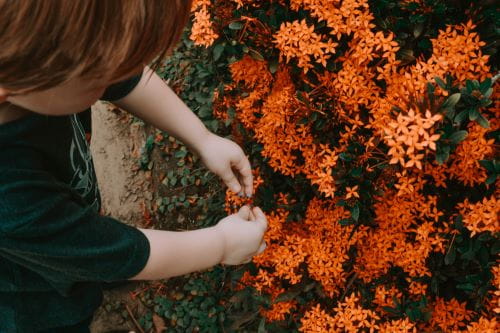Gardening with children in autumn offers families a fun way to usher in the new season and reap the benefits of being outdoors. Spending time in nature is shown to relieve stress, boost attention, and strengthen self-discipline. Studies show emotional, physical, and academic benefits for children too. A Kaiser Family Foundation survey in 2009 found children ages 8 – 18 spent an average of 7.5 hours each day in front of a screen for entertainment. That number did not include the hours spent in front of a screen for schoolwork. More recently in the pandemic, adult screen time has been estimated as high as 19 hours per day. It isn’t too late. Autumn can be a time to get outside and away from screens to enjoy everything a garden has to offer you and your family. If you do not have a yard, consider starting a container garden on a patio or veranda. Yard sales and thrift stores often have inexpensive pots or you can reuse old coffee or tea tins, just be sure to drill a drainage hole at the bottom. Some towns and cities have community gardens, so check if there is a waitlist and sign up.
Autumn Garden Activities
Plant Native Perennial Flowers, Shrubs, and Trees
Fall is a good time for perennials to establish themselves before temperatures drop below freezing. With your child, choose host plants for the butterflies and moths you’d like to welcome to your garden. For example, if you want to attract monarchs, plant a garden filled with milkweed (the only plant monarch caterpillars can eat). If you’d like to support beneficial insects in general and other wildlife, including birds, plant an oak tree. Refer to your Native Plant Society chapter for more planting suggestions and check out the National Wildlife Federation’s list of keystone species for your area. Most native plant society chapters hold seed swaps, where newcomers are welcome to free seeds and seedlings. Lastly, it’s important to refrain from spraying your property with weed killers, pesticides, and fertilizers as they contain chemicals that kill pollinators and other wildlife.
There are organizations that offer free trees, from national organizations like the Arbor Day Foundation to city-specific organizations like MillionTreesNYC. Check with your city hall or local librarian for more suggestions.
Go on a Nature Walk
Observe dried flower stalks, especially of host plants, to see if your child can spot any chrysalises or cocoons. The chrysalises and cocoons are very well-camouflaged so don’t be too disappointed if you don’t spot any right away. The majority of beneficial insects hide under fallen leaves in a larval stage (often as tiny, tiny caterpillars). Also, talk to your child about how other creatures hibernate in winter. Observe groundhog, skunk, and bird behavior as the weather turns cold.
Start a Nature Journal
For older children a nature journal can be a place for in-depth observations and questions. For younger children, a journal might be a collection of garden drawings stapled together. Talk with your child about their observations and help them research topics of interest.
Digital Photography
Do you own an old digital camera with an SSD card? Letting your child take numerous photos in the garden can help hone observation skills and encourage creativity. Consider printing out photos to create a photo essay and allow your child to choose how to group or display the images.
Plant Cold Weather Crops
A few vegetables like cauliflower and broccoli, prefer cool weather. If you’ve had success with vegetable gardening in summertime, consider extending the growing season into fall. Remember if starting plants by seed, sow early enough before fall starts. Studies show that students who participate in gardening enjoy eating more vegetables. Cooperatives (Co-ops) are a great way to become involved in community-oriented, locally harvested food. Many offer membership where everyone contributes a certain number of hours of gardening in exchange for a share of the produce. Check with your city hall or librarian for local organizations.
Press Flowers and Leaves
Another way to connect with plants is to collect leaves and flowers. Place flowers and leaves in an old, large book in between absorbent paper. After a month or so the flowers should be ready to be used in art projects or to create a garden journal.
Plan for Next Year
Is there a specific butterfly your child wants to attract to the garden? Add the host plant to next year’s planting list. Is there a certain bird species your child would like to observe? Find out if the bird eats berries, insects, or seeds then find berry and seed plants. For insect-eating birds, leave fallen leaves on the ground.
Best Practices for a Natural Yard
In autumn, many people clean up their gardens by raking leaves, cutting dried flower stalks, and ripping up dried annuals (flowers and vegetables that only bloom for one season). However, this way of cleaning destroys shelter for pollinators which need to stay warm over winter. The cleanup also deprives the land of its natural process of creating soil through decomposed organic matter—like leaves. As pollinator populations continue to decline, consider practicing habitat gardening where the ecosystem’s health is more important than a grass, turf-lawn aesthetic. Allow leaves to lie on the ground if only under trees and shrubs. Dried flower heads and stalks must be left as they are. Both practices replenish soil while giving butterflies, moths, and other beneficial insects a safe place to hide during winter inside flower stalks and under leaves. Check out the National Wildlife Federation’s tip sheet for more ways to make your yard wildlife-friendly.
Autumn gardening is a simple way for families to reconnect with nature and wildlife before cold weather keeps everyone indoors. Gardening offers physical and emotional benefits to the entire family, but sharing time together as a family engaged with nature might be the best.
Interested in writing a guest post for our blog? Let us know!
The opinions expressed in Montessori Life are those of the authors and do not necessarily represent the position of AMS.


